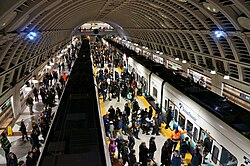Spanish solution | |||||||||||||||||||||
|---|---|---|---|---|---|---|---|---|---|---|---|---|---|---|---|---|---|---|---|---|---|

In railway and rapid transit parlance, the Spanish solution is a station layout with two railway platforms, one on each side of a track, [1] which allows for separate platforms for boarding and alighting.
Contents
The Spanish solution is used in several stations of the Madrid Metro (e.g. Avenida de América) and Barcelona Metro (e.g. Sant Andreu).






